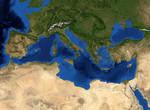|
|
Creato da poppi16 il 05/03/2009
discutere e condividere esperienze ed idee per la salvaguardia del Mediterraneo Mar Nero
|
ISCRIVITI ALLA FISPMED ONLUS
Scarica, compila ed inviaci il modulo a fispmed@gmail.com , contribuirai a sostenere i progetti di sviluppo sostenibile e lotta alla povertà nel Mediterraneo Mar Nero. Diventa anche Tu amico della FISPMED, clicca sul link qui sotto e segui le istruzioni.
|
Partecipa al gruppo facebook: amici del Mediterraneo Mar Nero per sviluppare iniziative, conoscenze, storie di amicizia, collaborazione, cooperazione tra le diverse sponde del Mediterraneo Mar Nero; per uno sviluppo socio economico sostenibile e duraturo per sostenere la lotta alla povertà e all'esclusione per favorire la democrazia e la crescita della qualità della vita tra i nostri popoli e i nostri paesi affinchè le nostre Patrie siano accoglienti e prospere e non ci costringano ad emigrare e ad abbandonare le nostre case, culture, lingue, tradizioni
|
PIANTA ANCHE TU UN ALBERO

http://www.unep.org/billiontreecampaign/index.as
Gli Amici del Mediterraneo e del Mar Nero
5 per mille x l'ambiente e la lotta alla povertà
Con un piccolo gesto gratuito puoi proteggere il Mediterraneo – Mar Nero. Puoi finanziare progetti per lo sviluppo sostenibile e la lotta alla povertà. Nella tua dichiarazione scegli di destinare il tuo 5 per mille alla FISPMED ONLUS, inserisci nello spazio “codice fiscale del beneficiario” il CODICE FISCALE della FISPMED ONLUS 94062080173 Entra nel sito www.donaconunsorriso.org
Partecipa alla Maratona di Milano con FISPMED ON
vieni a trovarci.
Tag
Cerca in questo Blog
Area personale
Cerca in questo Blog
Menu
Ultimi commenti
Chi può scrivere sul blog
| « Expo 2015: Stati Generali | Israel expected to propo... » |
Crops face toxic timebomb in warmer world: study
By David Fogarty, Climate Change Correspondent, Asia
SINGAPORE (Reuters) - Staples such as cassava on which millions of people depend become more toxic and produce much smaller yields in a world with higher carbon dioxide levels and more drought, Australian scientists say.
The findings, presented on Monday at a conference in Glasgow, Scotland, underscored the need to develop climate-change-resistant cultivars to feed rapidly growing human populations, said Ros Gleadow of the Monash University in Melbourne.
Gleadow's team tested cassava and sorghum under a series of climate change scenarios, with particular focus on different CO2 levels, to study the effect on plant nutritional quality and yield.
Both species belong to a group of plants that produce chemicals called cyanogenic glycosides, which break down to release poisonous cyanide gas if the leaves are crushed or chewed.
Around 10 percent of all plants and 60 percent of crop species produce cyanogenic glycosides.
The team grew cassava and sorghum at three different levels of CO2; just below today's current levels at about 360 parts per million in the atmosphere, at about 550 ppm and about double at 710 pm.
Current levels in the air are just under 390 ppm, around the highest in at least 800,000 years and up by about a third since the start of the Industrial Revolution.
"What we found was the amount of cyanide relative to the amount of protein increases," Gleadow told Reuters from Glasgow, referring to cassava.
At double current CO2 levels, the level of toxin was much higher while protein levels fell.
The ability of people and herbivores, such as cattle, to break down the cyanide depends largely on eating sufficient protein.
Anyone largely reliant on cassava for food, particularly during drought, would be especially at risk of cyanide poisoning.
HARDY STAPLE
While it was possible to use processing techniques to reduce the level of toxin in the cassava leaves, it was the 50 percent or greater drop in the number of tubers that caused most concern, Gleadow said.
About 750 million people in Africa, Asia and Latin America rely on cassava as a staple. The starchy tubers are used to make flour and the plant is ideal in dry regions because of its hardy nature.
The good news was that the levels of toxin in the tuber didn't increase with CO2, unlike the edible leaves.
|
|





Inviato da: vitosideb
il 30/03/2011 alle 22:15
Inviato da: poppi16
il 10/07/2009 alle 22:11
Inviato da: Alice_Scarcella
il 06/07/2009 alle 12:55
Inviato da: lanascitadiblusub
il 21/06/2009 alle 09:48
Inviato da: lanascitadiblusub
il 25/05/2009 alle 23:33